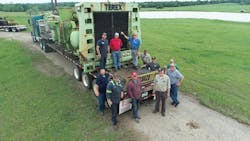Introduced in May, 1971, after extensive testing, the 33-15 was the first model in Terex’s line of electric-drive off-highway end dumps. Built by the Diesel Division of GM Canada Ltd. in London, Ontario, it was rated at 150 tons or 95 cubic yards heaped capacity, and weighed 117 tons empty. It measured 41 feet 10 inches long, 20 feet 7 inches wide, and 18 feet 8 inches high. Loading height was 16 feet 1 inch.
Quite appropriately for a truck built at a locomotive factory, the powertrain was much like that of a diesel-electric locomotive. It was powered by a GM 16V-149T1, 16-cylinder, two-cycle, turbocharged and intercooled diesel rated at 1,600 gross or 1,445 flywheel horsepower running at 1,900 rpm. The engine drove an AC generator supplying current to a solid-state rectifier bank that converted AC to DC to power two drive motors in the rear axle. Unlike most electric drive trucks of that era with their drive motors mounted in the wheel hubs, the DC motors in the 33-15 were located in the axle, with a planetary final reduction in each wheel hub. This method was said to ease maintenance where the electric motor was separated from the gear reduction.
The last surviving example of an original version 33-15 was involved in a serious accident at a copper mine in Utah. Terex offered to buy it back for $25,000, but John Cassidy of Stroud, Oklahoma, was also interested in it. Cassidy eventually outbid Terex and had it trucked to his property, where he performed a mechanical restoration without fully reassembling and mounting the bed. He was never able to finish the work, and the truck was put up for sale in an online auction late in 2019, with a scrapper placing the high bid. After much consideration as to what exactly was going to be involved, Larry Kotkowski, a national director of the Historical Construction Equipment Association (HCEA), purchased the truck and donated it to HCEA’s National Construction Equipment Museum in Bowling Green, Ohio.
That was the easy part. From March, 2020, through April, 2021, HCEA members thoroughly evaluated the truck and arranged the logistics of its disassembly and shipment. The project was completed in May, 2021, with a number of individuals making extremely generous donations of haulage, mechanical and cargo services, equipment usage, finances, and time. Each of the seven trucks and trailers involved racked up about 2,500 miles, and the crew involved in the disassembly and trucking gave two full weeks of their time to the effort, plus all that went before. Meanwhile, volunteers at the museum donated time to prepare a pad suitable for the truck’s massive weight.
Less its main frame and engine, which were routed to Cleveland for overhaul, the truck was delivered to the museum on May 21, 2021. The halves of the dump box were on one side of the display pad and everything else, except for some minor pieces, on the other. One of the HCEA members loaned a Clark 15-ton forklift to the museum for the work, hauling it from Pittsburgh to Bowling Green and back at his expense. The box halves were placed a carefully measured distance apart with the side walls facing each other and a stack of cribbing between them, then rolled over 180 degrees so that the cut between them met for welding.
The museum is hosting HCEA’s 2022 International Convention and Old Equipment Exposition on September 23-25, and one of the main attractions will be the major reassembly of the truck. Once complete, it will be a focal point that will help draw attention to the museum.
The HCEA thanks all who have contributed to this tremendous project. If you would like to donate toward the costs of its completion, please contact HCEA at 419.352.5616 or www.hcea.net. A one-year membership is offered in appreciation for donations of $100, one per member, please.





